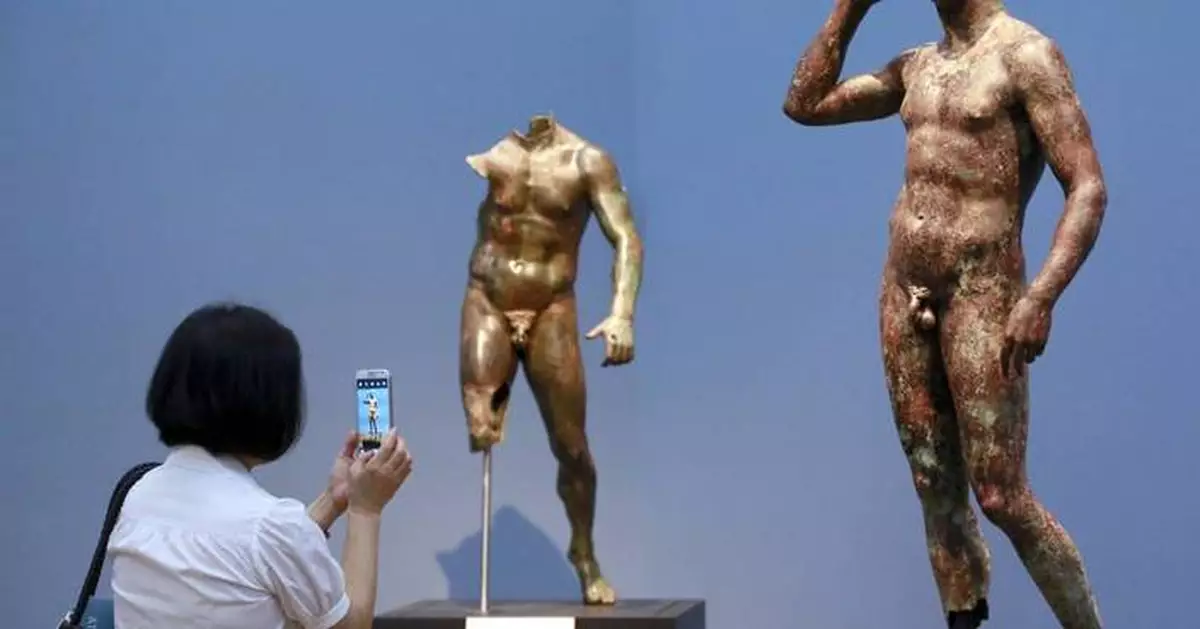ROME (AP) — A European court on Thursday upheld Italy’s right to seize a prized Greek statue from the J. Paul Getty Museum in California, ruling that Italy was justified in trying to reclaim an important part of its cultural heritage and rejecting the museum's appeal.
The European Court of Human Rights, or ECHR, determined that Italy’s decades-long efforts to recover the “Victorious Youth” statue from the Malibu-based Getty were not disproportionate.
“Victorious Youth,” a life-sized bronze dating from 300 B.C. to 100 B.C., is one of the highlights of the Getty's collection. Though the artist is unknown, some scholars believe it was made by Lysippos, Alexander the Great’s personal sculptor.
The bronze, which was pulled from the sea in 1964 by Italian fishermen and then exported out of Italy illegally, was purchased by the Getty in 1977 for $4 million and has been on display there ever since.
The Getty had appealed to the European court after Italy's high Court of Cassation in 2018 upheld a lower court's confiscation order. The Getty had argued that its rights to the statue, under a European human rights protocol on protection of property, had been violated by Italy’s campaign to get it back.
The court ruled Thursday that no such violation had occurred.
“This is not just a victory for the Italian government. It's a victory for culture,” said Maurizio Fiorilli, who as an Italian government attorney had spearheaded Italy's efforts to recover its looted antiquities and, in particular, the Getty bronze.
The Getty has long defended its right to the statue, saying Italy had no legal claim to it.
Among other things, the Getty had argued that the statue is of Greek origin, was found in international waters and was never part of Italy’s cultural heritage. It cited a 1968 Court of Cassation ruling that found no evidence that the statue belonged to Italy.
Italy argued the statue was indeed part of its own cultural heritage, that it was brought to shore by Italians aboard an Italian-flagged ship and was exported illegally, without any customs declarations or payments.
After years of further legal wrangling, an Italian court in Pesaro in 2010 ordered the statue seized and returned, at the height of Italy’s campaign to recover antiquities looted from its territory and sold to museums and private collectors around the globe.
Thursday’s ruling by the Strasbourg, France-based ECHR was a chamber judgment. Both sides now have three months to ask that the case be heard by the court’s Grand Chamber for a final decision. But Thursday's ruling was unanimous, with no dissenting judges, and the Grand Chamber can refuse to hear the case.
There was no immediate comment from the Getty, and its lawyers referred comment to the museum.
Italian Culture Minister Gennaro Sangiuliano praised Thursday's decision as an “unequivocal ruling” that recognized the rights of the Italian state and its ownership of the statue.
“Following today’s ruling … the Italian government will restart contacts with U.S. authorities for assistance in the implementation of the confiscation order,” he said.
In a statement, he doubled down on Italy’s campaign to bring its looted treasures home, and noted that recently Italy has ceased cooperation with foreign museums that don’t recognize Italian legal confiscation orders.
Recently, Italy banned any loans to the Minneapolis Institute of Art following a dispute over an ancient marble statue believed to have been looted from Italy almost a half-century ago.
The Getty had appealed to the ECHR by arguing, among other things, that Italy's 2010 confiscation order constituted a violation of its right to enjoy its possessions and that it would be deprived of that right if U.S. authorities carried out the seizure.
The ECHR however strongly reaffirmed Italy's right to pursue the protection of its cultural heritage, especially from unlawful exportation.
"The court further held that owing, in particular, to the Getty Trust’s negligence or bad faith in purchasing the statue despite being aware of the claims of the Italian state and their efforts to recover it, the confiscation order had been proportionate to the aim of ensuring the return of an object that was part of Italy’s cultural heritage," said the summary of the ruling.
It wasn’t immediately clear what would happen next, though Fiorilli said the Getty had exhausted legal remedies and it’s now for U.S. the courts to enforce the Italian confiscation order.
“It’s not about guaranteeing the right to property, it’s about guaranteeing the internationally recognized value of every nation’s right to protect its cultural patrimony,” Fiorilli told The Associated Press over the telephone.
The statue, nicknamed the “Getty Bronze,” is a signature piece for the museum. Standing about 5 feet (1.52 meters) tall, the statue of the young athlete raising his right hand to an olive wreath crown around his head is one of the few life-sized Greek bronzes to have survived.
The bronze is believed to have sunk with the ship that was carrying it to Italy after the Romans conquered Greece. After being found in the nets of Italian fishermen trawling in international waters in 1964, it was allegedly buried in an Italian cabbage patch and hidden in a priest’s bathtub before it was taken out of the country.
Italy has successfully won back thousands of artifacts from museums, collections and private owners around the world that it says were looted or stolen from the country illegally, and recently opened a museum to house them until they can be returned to the regions from where they were looted.
The most important work to date that Italy has successfully brought back is the Euphronios Krater, one of the finest ancient Greek vases in existence. The Metropolitan Museum of Art in New York, which purchased it for $1 million in 1972 from an art dealer later accused of acquiring looted artifacts, returned it to Italy in 2008.
In 2010, the same year that Italy ordered the “Victorious Youth” statue confiscated from the Getty, a criminal trial ended in Rome against the Getty's former curator of antiquities, Marion True. After years of trial, the Rome court ruled that the statute of limitations had expired on charges that True received stolen artifacts. She has denied wrongdoing.
In 2007, the Getty, without admitting any wrongdoing, agreed to return 40 ancient treasures in exchange for the long-term loans of other artifacts. Similar deals have been reached with other museums.
Under the 2007 deal, the two sides agreed to postpone further discussion of “Victorious Youth” until the court case was decided.

FILE - Reporter Sookee Chung takes a photo of a sculpture titled "Statue of a Victorious Youth, 300-100 B.C." at the J. Paul Getty Museum in Los Angeles, on July 27, 2015. A European court upheld Italy’s right to seize a prized Greek statue from the J. Paul Getty Museum in California, rejecting the museum’s appeal on Thursday and ruling Italy was right to try to reclaim an important part of its cultural heritage. (AP Photo/Nick Ut, File)












